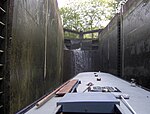Bathwick Hill

Bathwick Hill in Bath, Somerset, England is a street lined with historic houses, many of which are designated as listed buildings. It climbs south east from the A36 towards the University of Bath on Claverton Down, providing views over the city. To the north is Sham Castle, a folly built in 1762 by Richard James, master mason for Ralph Allen, "to improve the prospect" from Allen's town house in Bath. It is a screen wall with a central pointed arch flanked by two 3-storey circular turrets, which extend sideways to a 2-storey square tower at each end of the wall. It is illuminated at night.As the hill rises away from the city centre it passes over a tunnel, built in 1840, on the Great Western Railway close to Bath Spa railway station and the Kennet and Avon Canal at Bath Locks via an elliptical arch bridge.
Excerpt from the Wikipedia article Bathwick Hill (License: CC BY-SA 3.0, Authors, Images).Bathwick Hill
Bathwick Hill, Bath Bathwick
Geographical coordinates (GPS) Address Nearby Places Show on map
Geographical coordinates (GPS)
| Latitude | Longitude |
|---|---|
| N 51.379444444444 ° | E -2.3427777777778 ° |
Address
Bathwick Hill
BA2 6EL Bath, Bathwick
England, United Kingdom
Open on Google Maps










